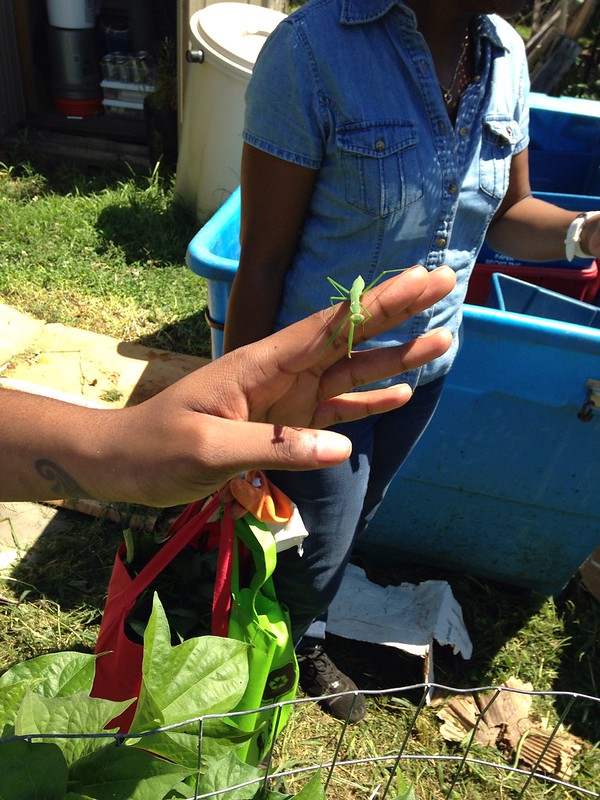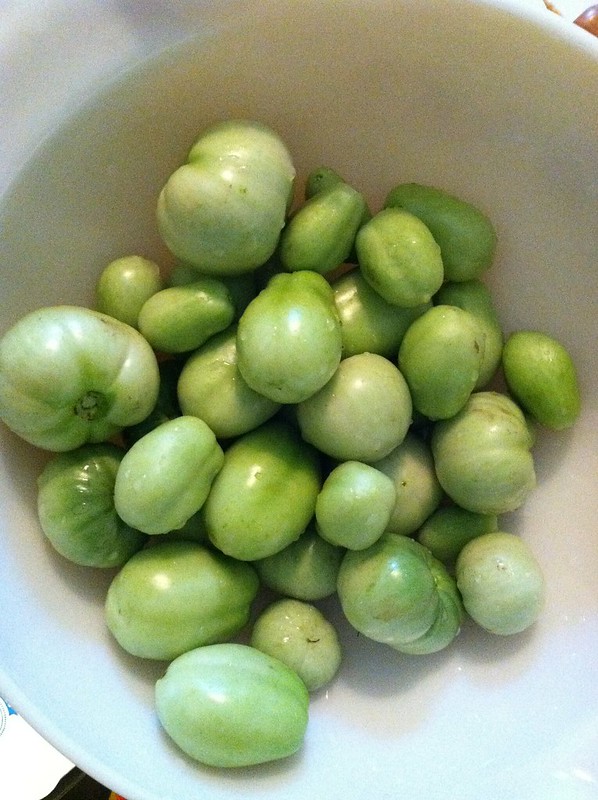
We are a work/share garden in Charlotte, NC, located at the corner of 17th St. and Alexander. We're open most Saturdays from 9 AM to 12 PM. Come by and work, stay for a crafty event, and take home some fresh produce. Even when the gate isn't open, there are vegetables growing outside the fence that we're glad to share with you.
Saturday, July 26, 2014
Monday, June 30, 2014
Not Fried Green Tomatoes
Though we're mainly harvesting squash and zucchini from the garden, the tomatoes are coming in nicely. Unfortunately we've been so caught up in battling overgrown grass that the tomatoes have started producing and we haven't gotten them all staked and pruned!
On the upside, we had a big harvest of green tomatoes just from the tomato prunings. While the other gardeners took their share for frying, last year I mentally bookmarked the idea of a green tomato tart. I looked into a few recipes and loosely based my recipe on this one from The Egg Farm.
I changed the recipe to what I thought would better suit my family's tastes since we have 2 little ones and a husband who is well-versed in southern foods. I added 2 layers of sauteed onions, a generous amount of thyme to the grated (Munster) cheese, and bacon. The sauteed onions added enough extra oil that you don't need to brush the pastry dough before filling it with the ingredients. Oh, and pile up the filling really high. I filled ours up to where I wondered if it would be too much and after it cooked I realized I could've added much more filling.
Thursday, May 15, 2014
Garden-Fresh Sodas
For those who came out to the tour and tried the herb-infused simple syrups, the recipe is really easy, hence the name simple!
1 cup boiling hot water
1 cup sugar stirred into water until dissolved
1/2 cup herbs of choice steeped in the sugar water for 10 minutes. While you're steeping the herbs, make sure you cover the container with a lid or plate so the oils don't escape with the steam. Every so often stir and bruise the herbs in the mixture. After 10 minutes, filter the herbs from the syrup, store the flavored syrup in the refrigerator for up to 2 weeks.
Use lavender syrup in lemonade, mint in mojitos, lemon balm and seltzer as a homemade garden-fresh soda...the options are endless!
Monday, May 12, 2014
May 10, 2014
This weekend we exhausted ourselves with planting. There's still (always!) plenty of weeding to be done, but in lieu of that un-fun stuff, we put in yarrow around the base of the grape vine, yellow cherry and Mr. Stripy tomatoes in rows, tons of bell peppers perennial flowers and a couple milkweed transplants that may or may not make it, and basil and veggies outside the fence. We already have cucumbers, sweet potatoes, potatoes, loofah, greens, dent corn, and a handful of perennial veggies in the ground. In a few more weeks things should really be filling in.
Tuesday, May 6, 2014
For your own yard and beyond
Attention Nature Loving Pals! HAWK Matthews is hosting Habitat Steward Training on June 23-25, 2014 in Matthews at the Community Center.
Call Debbie at 704-841-1372 for more information.
Monday, March 24, 2014
Peas Please!
Shelling peas are what we're used to buying canned or frozen at the grocery store. They're the peas you "shell" or harvest from the pod once they plump on the vine. We'll also plant sugar peas, which are the flat, tender peas which are picked young and eaten pod and all. Sometimes these require stringing, but often are picked young and tender enough they don't need it. We'll also have a plot of snap peas, which are a hybrid of shelling and sugar peas and are picked when the peas have plumped but before the pod walls have thickened. When picked at this time, the pea will be sweet and tender, and can be eaten pod and all.
What we've planted as described by High Mowing and Sow True:
Green Arrow Shelling Peas Bushy plants grow 24-28" vines that do fine with minimal support. Reliable producer of double borne pods 4-5" long. Resistant to many common diseases.Days to maturity: 65 days
Laxton's Progress #9 Shell Pea - A leading garden pea with short vines and plump pods that hold dark-green peas of excellent quality. Small 15-20” plants produce heavy yields of 4-5” long pods, with up to nine peas per pod (hence the name). An improvement over the original Laxton’s Progress with a high resistance to wilt. (Pisum sativum)Days to maturity: 60 days
Organic Early Wonder Tall Top Beet - Earliest variety! Quick growing arching tops make perfect beet greens for a first harvest, while roots size up quickly for a second harvest of delectable baby bunched beets. Early Wonder also makes for a wonderful full size beet with vibrant tops. Not as hardy as Detroit Dark Red, but of similar quality for early season crops. (Beta vulgaris) Days to maturity: 45 days
Detroit Dark Red, ORGANIC Beta vulgaris HEIRLOOM This is the beet that fell in love with a mason jar! A consistent producer for canning, juicing, pickling, or roasting. Burgundy globe-shaped roots with bright green leaves and little zoning. Days to maturity: 50-60 days
In full disclosure: This year's crops are largely in thanks to High Mowing Seeds and Sow True Seed, two companies who generously donated a fantastic array of seeds to our garden. As a grow share garden, we do not charge plot fees, and therefore do not have a source of income. We rely on donations to keep our organic garden growing!
Monday, February 10, 2014
Getting seeds in the soil
This year we're relying on donations from High Mowing Seeds and Sow True to fill our rows. The High Mowing seeds arrived on Saturday and I immediately sat down to play with (oops, organize) them.
Sorry for the bad phone pics. I couldn't peel my hands from the package long enough to get a proper camera. I started one flat of 72 cells to get a few seeds going. Now is the time to start your perennials from seed (echinacea and herbs for example). Looks like we have a few weeks to get the rest of our starts going. We are about 9 weeks out from our average last frost date of April 15; most veggie seeds that get an indoor head start should be sown 4-6 weeks from that date.
Subscribe to:
Posts (Atom)














